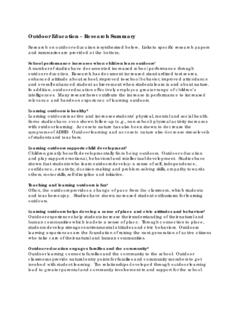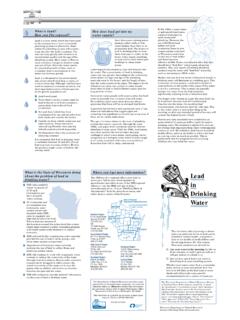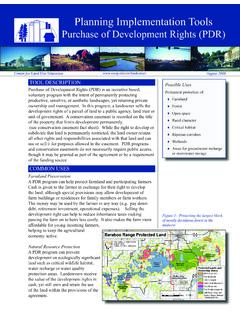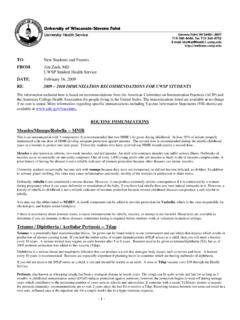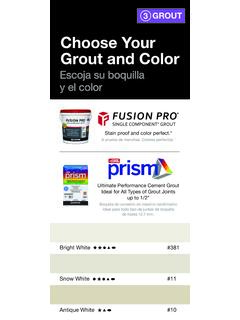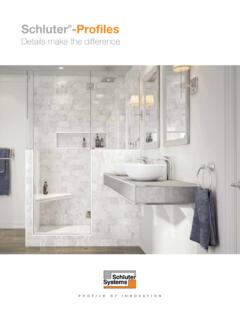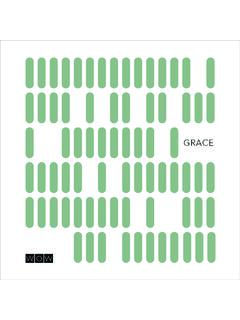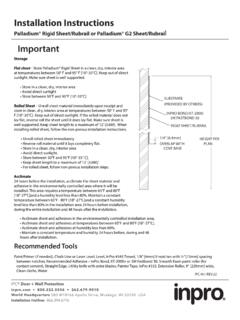Transcription of Interpreting Drinking Water Quality Results
1 Homeowner s Package This fact sheet is intended to help you interpret the Results of commonly recommended analyses for Drinking Water from private wells in Wisconsin. Some of these tests are important because they deal with health related contaminants; the other tests will tell you about important characteristics of your well Water , such as how hard or corrosive it is. Using this fact sheet I N D I V I D U A L T E S T S : Interpreting Drinking Water Quality Results Identifying Problems and Solutions Bacteria - Coliform Coliform bacteria are microorganisms that are found in surface Water and soil. This test is used as an indicator of the sanitary condition of your well. It is the most important test to perform on a well. A sanitary well should not contain any coliform bacteria. While coliform bacteria do not usually cause disease, their presence in a Water sample indicates a potential pathway for fecal wastes and other disease causing organisms to enter your well.
2 If human or animal wastes are contaminating the Water , gastrointestinal diseases, hepatitis, or other diseases may result. If coliform bacteria is present, many laboratories will also test for , a type of fecal coliform. The presence of E. coli in a Water sample is more conclusive evidence of fecal contamination which represents an even greater health risk than the presence of coliform bacteria. (Continued on p. 2.) Bacteria - Coliform 1 Hardness - Total 2 Alkalinity 3 Conductivity 3 pH 3 Saturation Index 4 Nitrogen - Nitrate 4 Chloride 5 Your result is either: ABSENT = No coliform bacteria are present. Your Water supply is bacteriologically safe. No further action is needed at this time. Consider testing your well again in a year for bacteria or sooner if you notice a sudden change in taste, color or odor.
3 Or PRESENT = Coliform bacteria are present; Water supply is considered bacteriologically unsafe. Until the source of the problem is identified and corrected, we recommend using an alternative source of Drinking Water or boiling Water for 5 minutes before using for Drinking or cooking What should you do if coliform bacteria are present? If coliform bacteria are present in a Water sample we recommend carefully resampling to rule out sampling error. If a second test confirms the original test, take corrective action outlined here: Bacteria Coliform 1. Check well for sanitary defects. Some common examples include: Well cap is loose or missing (well cap should be a vermin proof cap). Casing is cracked or rusted through, or casing does not extend 12 inches above grade. Inadequate grout (seal or fill around well casing).
4 2. After correcting any visible defects, disinfect with a dilute bleach solution using the procedure outlined by the Department of Natural Resources brochure entitled Bacteriological Contamination of Drinking Water Wells . 3. Test again after bleach dissipates to ensure that the procedure was effective. Hardness measures the amount of calcium and magnesium in Water . Hardness is primarily caused by Water slowly dissolving rocks that contain calcium and magnesium. There are no health concerns associated with Drinking hard Water , however it is often undesirable because it can cause lime buildup (scaling) in pipes and Water heaters. Hard Water reacts with soap which can decrease its cleaning ability and hard Water also causes build up of soap scum and/or graying of white laundry over time. Hardness - Total Some people that use hard Water for showering may notice problems with dry skin.
5 Calcium and magnesium are essential nutrients, however Drinking hard Water is generally not a significant source of calcium and magnesium dietary needs. Water that is naturally low in total hardness (referred to as soft Water ) may be corrosive. Note the Water softening industry measures hardness in grains per gallon. 1 grain per gallon = mg/L CaCO3. Acceptable Results : Total hardness is a test for overall Water Quality ; there are no health concerns related to total hardness. Values near 150 mg/L are generally ideal from an aesthetic viewpoint. Water less than 150 mg/L are considered soft Water while values greater than 200 mg/L are considered hard Water . Sources: Primarily dissolved carbonate minerals from soil and rock materials. When carbonate minerals dissolve they increase the amount of calcium and magnesium ions in Water .
6 Additional information about bacteria in wells: In areas where fractured bedrock aquifers are overlain by thin soils, bacteria in a well may be the result of geologic conditions which do not allow for adequate filtration of Water before reaching a well. You may suspect this if Water suddenly changes color or odor following large rain events. For wells that are consistently contaminated with bacteria, disinfection may not solve the problem. In this case the best solution may be to drill a new well. Inter pre tin g D rink ing W ate r Quali t y Resul ts Page 2 Corrective Action for Hard or Corrosive Water If you are experiencing problems with hard Water : Consider softening Water using a Water softener. Softened Water removes calcium and magnesium and replaces it with another cation (usually sodium).
7 Many people choose not to soften the cold Water tap used for Drinking and cooking. If you are experiencing problems with corrosion of household plumbing: Install a Water treatment device (neutralizer) designed to make Water less corrosive. Install plastic plumbing which will not develop pinhole leaks or leach metals. If you have a shallow well, drilling deeper may produce less corrosive Water . Water allowed to contact unprotected metal plumbing for extended periods can dissolve unsafe levels of copper and/or lead. If levels of copper or lead in Drinking Water are a concern, run Water for a few minutes before using for Drinking or cooking. 0 50 100 150 200 Soft Moderate Hard Did you know that your well Water is actually groundwater? Groundwater is Water that occupies void spaces between soil particles or cracks in rock below the land surface.
8 It is a local resource that originates as precipitation which infiltrates into the ground. The type of soil and bedrock that a well is drilled into often determines Water s pH, saturation index, or the amount of hardness or alkalinity in Water . The type of soil and bedrock in a region also determines how quickly contaminants can reach groundwater. Human activities are often responsible for elevated levels of contaminants such as nitrate and chloride. Iden tif yi ng P rob le ms and S olu tio ns Page 3 Alkalinity is a measure of Water s ability to neutralize acids. It Results primarily from dissolving limestone or dolomite minerals in the aquifer. Alkalinity and total hardness are usually nearly equal in concentration (when they are both reported in mg/L CaCO3 (calcium carbonate) because they form from the same minerals.)
9 If alkalinity is Alkalinity much greater than total hardness, it may indicate that your Water has passed through a Water softener. If alkalinity is much less than total hardness it may signify elevated levels of chloride, nitrate or sulfate. Water with low levels of alkalinity (less than 150 mg/L) is more likely to be corrosive. High alkalinity Water (greater than 150 mg/L) may contribute to scaling. Acceptable Results : This is a test for overall Water Quality . There are no health concerns related to alkalinity. The value should be roughly 75% to 100% of the total hardness value in an unsoftened sample. Sources: Primarily dissolved carbonate from soil or rock materials. Conductivity is a measure of the ability of Water to conduct an electrical current. It is related to the amount of dissolved substances (or ions) in Water , but does not give an indication of which minerals are present.
10 Conductivity (measured in umhos/cm at 25 C) is about twice the total hardness value (mg/L CaCO3) in most uncontaminated waters. Conductivity Changes in conductivity over time may indicate changes in your overall Water Quality . Acceptable Results : This is a test for overall Water Quality , there is no health standard associated with conductivity. A normal conductivity value is roughly twice the total hardness in unsoftened Water samples. If conductivity is much greater than two times the hardness, it may indicate the presence of other ions such as chloride, nitrate, or sulfate which may be human-influenced or naturally occurring. Sources: Natural or human-related dissolved substances in Water . pH The pH test measures the concentration of hydrogen ions in a solution. The concentration of hydrogen determines if a solution is acidic or basic.


